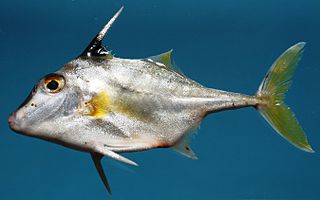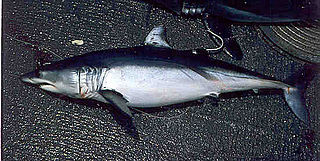
Batrachoididae is the only family in the ray-finned fish order Batrachoidiformes. Members of this family are usually called toadfish or frogfish: both the English common name and scientific name refer to their toad-like appearance.

The Gonostomatidae are a family of mesopelagic marine fish, commonly named bristlemouths, lightfishes, or anglemouths. It is a relatively small family, containing only eight known genera and 32 species. However, bristlemouths make up for their lack of diversity with relative abundance, numbering in the hundreds of trillions to quadrillions. The genus Cyclothone is thought to be one of the most abundant vertebrate genera in the world.

Argyripnus is an oceanic ray-finned fish genus in the marine hatchetfish family Sternoptychidae. They are commonly known as bristle-mouth fishes, but that may also refer to the related bristlemouth family (Gonostomatidae). A. iridescens is called "pearlside", which usually refers to the closely related genus Maurolicus.
The Chattian is, in the geologic timescale, the younger of two ages or upper of two stages of the Oligocene Epoch/Series. It spans the time between 27.82 and23.03 Ma. The Chattian is preceded by the Rupelian and is followed by the Aquitanian.

The tubeshoulders are a family, Platytroctidae, of ray-finned fish belonging to the order Alepocephaliformes. They are found throughout the world, except for the Mediterranean Sea. Tubeshoulders live at moderate depths of 300 to 1,000 m, and some have light-producing organs. They are generally small to medium fish, ranging from 9 to 33 cm in length.

Triacanthidae, commonly known as triplespines or tripodfishes, is a family of Indo-Pacific fishes. It is classified in the order Tetraodontiformes, along with the pufferfishes and the ocean sunfish. The family consists of seven species in four genera, in addition to one extinct genus that only is known from fossils.

Isurus is a genus of mackerel sharks in the family Lamnidae, commonly known as the mako sharks. They are largely pelagic, fast predatory fish capable of swimming at speeds up to 50 km/h (31 mph).

The Paratethys sea, Paratethys ocean, Paratethys realm or just Paratethys was a large shallow inland sea that stretched from the region north of the Alps over Central Europe to the Aral Sea in Central Asia.

Scomber is a genus of fish in the family Scombridae living in the open ocean found in Atlantic, Indian and Pacific Ocean. The genus Scomber and the genus Rastrelliger comprise the tribe Scombrini, known as the "true mackerels". These fishes have an elongated body, highly streamlined, muscular and agile. The eyes are large, the head is elongated, with a big mouth provided with teeth. They have two dorsal triangular fins, with some stabilizing fins along the caudal peduncle. The basic color is blue-green with a silvery white belly and a darker back, usually black mottled.

Caranx is a genus of tropical to subtropical marine fishes in the jack family Carangidae, commonly known as jacks, trevallies and kingfishes. They are moderate- to large-sized, deep-bodied fishes which are distinguished from other carangid genera by specific gill raker, fin ray and dentition characteristics. The genus is represented in the Pacific, Indian and Atlantic Oceans, inhabiting both inshore and offshore regions, ranging from estuaries and bays to deep reefs and offshore islands. All species are powerful predators, taking a variety of fish, crustaceans and cephalopods, while they in turn are prey to larger pelagic fishes and sharks. A number of fish in the genus have a reputation as powerful gamefish and are highly sought by anglers. They often make up high amounts of the catch in various fisheries, but are generally considered poor to fair table fishes.

Euzaphlegidae is a family of extinct escolar-like fish closely related to the snake mackerels. Fossils of euzaphlegids are found from Paleocene to Late Miocene-aged marine strata of Europe, the Caucasus Mountains, India, Iran, Turkmenistan, Italy, and Southern California.

Eophycis is an extinct genus of prehistoric morid gadiform fish that lived during the early Oligocene epoch in the Paratethys ocean in what now the Polish Carpathians.
Palimphyes is an extinct genus of prehistoric euzaphlegid bony fish related to the escolars and snake mackerels. The various species lived as deepwater mesopelagic predators in the Tethys and Paratethys oceans, with fossils of ten species found in Paleocene to Oligocene strata of the Swiss Alps, the Carpathian and Caucasus Mountains, Iran, India, and Turkmenistan.

Cyclothone is a genus containing 13 extant species of bioluminescent fish, commonly known as 'bristlemouths' or 'bristlefishes' due to their shared characteristic of sharp, bristle-like teeth. These fishes typically grow to around 1-3 inches, though some can be larger. They are most commonly found in the mesopelagic zone of the ocean, mostly at depths of over 300 meters, and many species have bioluminescence.
Glossanodon is a genus of fishes in the family Argentinidae.

Bonapartia pedaliota, the longray fangjaw, is a species of bristlemouth found in the Atlantic and Indian Oceans. It is the only described species in its genus. This species grows to a length of 7.2 centimetres (2.8 in) SL.

Margrethia is a genus of bristlemouths.
Peckoltia multispinis, commonly known as the bristlemouth catfish, is a species of small freshwater fish in the genus Peckoltia of the catfish family Loricariidae. It has the L-number L049. It is possibly a junior synonym for Peckoltia vittata. However, the online Encyclopedia of Life lists this fish as Lasiancistrus multispinis. The California Academy of Sciences lists Peckoltia multispinis as the currently correct name. This species is not to be confused with the valid but unrelated species Ancistrus multispinis, and although A. multispinis has been used as a name for both this species and the one it is currently used for, A. multispinis was initially described as a member of the now-invalid genus Xenocara and was classified under that genus when this species was first described as a member of Ancistrus. Because of this, Ancistrus multispinis is a valid name, but not one that should be used for P. multispinis.
This list of fossil fishes described in 2017 is a list of new taxa of jawless vertebrates, placoderms, acanthodians, fossil cartilaginous fishes, bony fishes and other fishes of every kind that are scheduled to be described during the year 2017, as well as other significant discoveries and events related to paleontology of fishes that are scheduled to occur in the year 2017. The list only includes taxa at the level of genus or species.
Cyclothone signata, the showy bristlemouth, is a species of ray-finned fish in the genus Cyclothone.















